All about rose sawflies
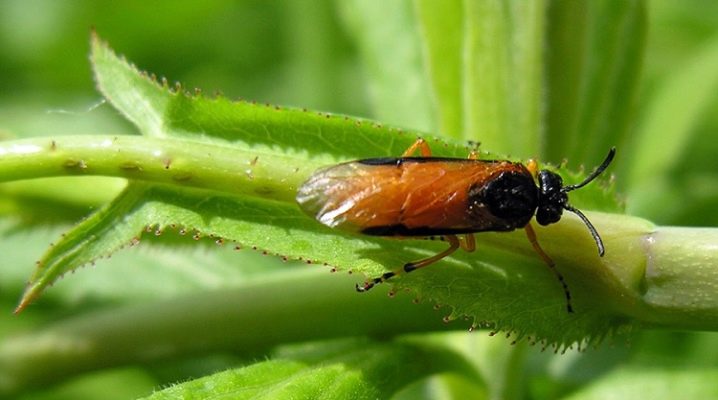
Gardeners and orchard plots are often decorated with roses. These amazing flowers immediately make the area green and add luxury to it. Roses also smell wonderful, filling everything around with scent. However, it is worth considering that such a culture is very susceptible to pest attacks, and the most important of them is the rose sawfly. The features of this insect, as well as measures to combat it, will be considered in the article.
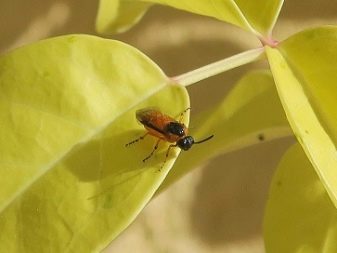

What do they look like?
The rose sawfly is a cross between a large ant and a wasp. It is a flying insect with a body length of about 7-10 millimeters. These sizes are quite enough to see the parasites on the bushes with your own eyes. Their color is bright. The body is yellow-orange, the head is black. The paws are yellow with black stripes. There are two thick antennae on the pest's head. The wings are thin, translucent, with a golden tint. There are several types of rose sawflies. The most common are ascending and descending. In the wild, pests are ubiquitous in Europe, America, Asia. Very often, such insects can be found in Siberia. Sawfly females are quite simple to distinguish from males: they have a thicker abdomen and have an ovipositor.
The approximate number of eggs laid by a female is 70; she can do several approaches. As a rule, laying is carried out under the bark of the shoots. The eggs are yellowish in color, they are translucent. After 10-11 days, pale caterpillars hatch from the eggs, which molt several times over the entire cycle of their development, constantly changing color. Caterpillars parasitize on foliage and stems, gnawing holes there and sucking out all the juices. When the larva is about 30 days old, it goes into the soil and pupates there. In this state, the insect calmly spends the winter, and in the spring it flies out as an adult.
The sawfly himself does not eat bushes, he feeds on pollen. The main harm from the insect is the laying of eggs and the appearance of gluttonous larvae.
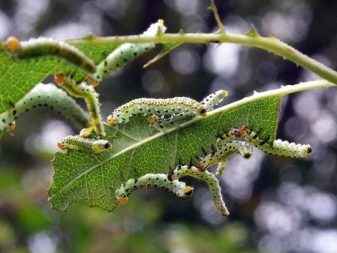
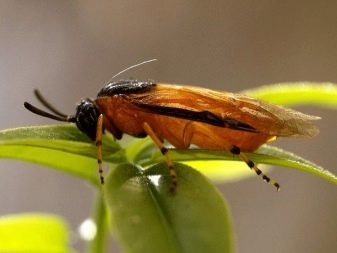
What harm is done?
Larvae cause damage to plants. Moreover, they parasitize not only on roses. In addition, insects can breed on strawberries, rose hips, and strawberries. Growing up, caterpillars leave huge holes in the foliage. For a plant, this does not go unnoticed. The processes of photosynthesis are disrupted, foliage begins to curl, the general immunity of the culture weakens. Affected bushes can lose resistance to cold weather, not survive the winter. In addition, sawflies can seriously delay flowering or even cause no flowering at all. If they parasitize, for example, on strawberries, then without flowering it simply will not yield a harvest.
Ascending sawflies crawl up the insides of the stem, descending, respectively, down. The larvae gnaw holes there, which makes the stems susceptible to any infection, including a viral one. Diseases are not long in coming in almost 100% of cases.
The presence of a sawfly on plants can be seen by the following signs:
- bushes of crops are subject to wilting even with enhanced and correct agricultural technology;
- deformations appear on the stems in the form of growths;
- if you break the stem, dark passages gnawed by larvae will be visible inside;
- holes appear on the foliage, the plates themselves dry quickly, lose color, fall to the ground;
- a light cobweb is clearly visible in the lower part of the stems.
Sawflies arrive at the site for various reasons. Insects are able to fly long distances, looking for food for themselves.If they find a wild rose hip on the site, they stop there for a long time, and then move on to roses and strawberries. Therefore, it is inappropriate to cultivate wild rose hips in the country. In addition, the gardener himself can contribute to the addition of pests. Perhaps he uses soil for planting in which there are larvae, or he did not remove plant debris from the site in time. The foliage and stems of affected crops must not be piled into a compost heap. This not only does not kill parasites, but also creates an optimal microclimate for them to develop.
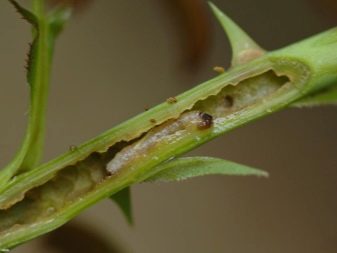
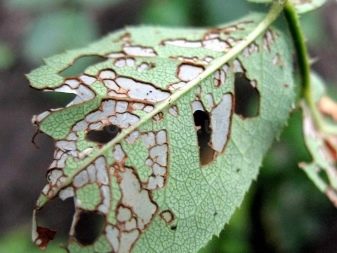
How to fight?
It is difficult to drive the sawfly from the rose bushes, but it is quite possible. To fight, gardeners use various techniques.
Insecticides
This is the most proven and fastest option, however, such drugs should always be used according to the dosage. When using them, the person must protect the hands and respiratory tract. Processing is carried out on a dry day in the absence of wind. You can choose one of the following drugs.
- Aktara. An excellent insecticide with neurotoxic effects. Begins to act within a couple of hours after spraying, protects bushes for 60 days. It is necessary to use the product carefully, because it kills not only pests, but also bees.
- Karbofos. This is a very toxic drug that causes the death of both adults and their larvae. Has an extremely unpleasant odor, works within 10 days. It will take about 3 treatments.
- Tanrek. Like the previous drug, this one also destroys insects of all ages. By eating the stems, the larvae are quickly poisoned. The duration of the action of the insecticide is 3 weeks. If this drug is chosen, only use it, it is incompatible with the rest. Laundry soap must be added to the solution for processing.
- Fitoverm. This is one of the most popular drugs among summer residents. It poisons the body of insects, and they die. Works within 20 days, less harmful than other products.
And also for the destruction of insects, you can treat the bushes with the following preparations:
- Angio;
- "Bitoxibacillin";
- Actellik;
- Calypso 480.


Traditional methods
It is quite possible to get rid of a small number of insects by resorting to folk methods of struggle. Here are the most productive options.
- Ash, mustard, tobacco dust. All these substances radically change the taste of the stems, and the larvae really do not like this, and they leave. In order for the composition to begin to work, you need to choose one thing, pour it under the bushes, water. The treatments are repeated every 7 days. You can alternate the compositions.
- Sagebrush. The sawfly will fly away from the rose bushes only upon smelling this unpleasant scent. You need to take 1 part of fresh raw materials, chop into small pieces, pour 3 parts of heated water. Next, place the container in a dark room for three days, then strain and spray the leaves and soil.
- Potato or tomato tops. You need to take 4 kilograms of tops, stir in a bucket of water. After a 30-minute infusion, boil for half an hour. When the liquid has cooled, it must be filtered and supplemented with grated soap. We use it according to the spraying technique.
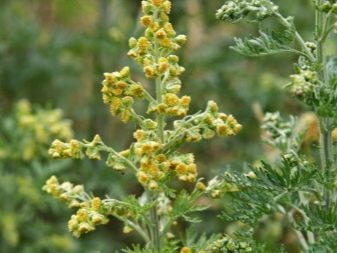

Preventive measures
It is quite possible to avoid the appearance of rose sawflies in the garden. The main thing is to follow a few simple rules for this.
- Provide proper plant care. Water according to the regimes they require, do not overdo it. Apply top dressing on time, loosen the soil and destroy weeds. Cut rose bushes according to the correct pattern, do not let them grow densely. Lack of air is the first step in attracting the sawfly to the site.
- Inspect your plantings regularly. The sawfly is easy to spot due to its bright color. If you find a pest, take action immediately.
- Planting herbs with a strong smell near bushes will scare off the rosy parasite. Sawflies will not like the aromas of wormwood, marigolds, calendula, and yarrow. Garlic feathers also scare off pests.
- In early spring and during autumn dormancy treat plants with a universal type of insecticide.
- Do not forget that the pupae hibernate in the soil. Therefore, in the autumn period, you need to dig up the soil. Most of the larvae die in this case.
Old plant residues have no place on the site. Healthy residues are loaded into compost heaps, and those that are located next to the affected bushes are burned.















The comment was sent successfully.